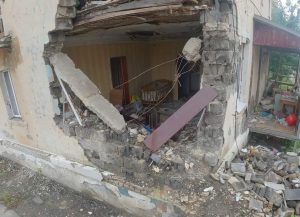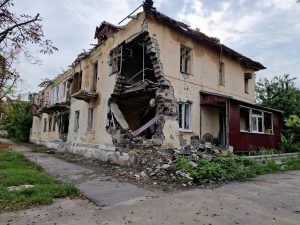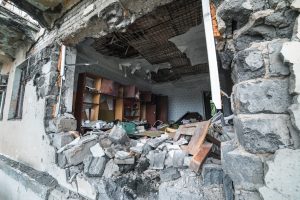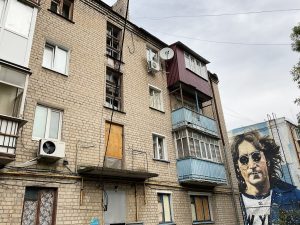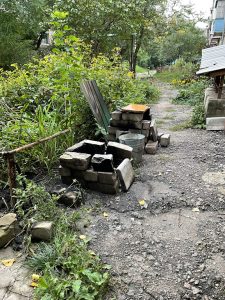The humanitarian disaster in Izyum as recalled by Nataliya Zubar in an interview with Ihor Kiianchuk.
Ihor Kiianchuk: I know that you recently visited the city of Izyum in the Kharkiv region. What was the purpose of the visit?
Nataliya Zubar: We went to Izyum on September 30, 2022 with an intersectional team to document war crimes. We were there with our partners, investigators of the Security Service of Ukraine in the Kharkiv region, with whom we have been working since March 2022. The group also included explosives technicians, drone operators, and our team was engaged in photo and video recording as usual.
What we saw before in Kharkiv is incomparable.
IC: When we go somewhere, we have some expectations from the trip. A person expects to see something, good or bad, but still expects something. To what extent did what you saw meet your expectations? What emotions did you experience?

NZ: When I read estimates from the authorities that Izyum is the most shelled city in Ukraine, I thought it was an exaggeration. In our practice, we are faced with the fact that the authorities can say that the town is completely destroyed, there is not a single house left intact. And then you come to document the destruction in a city of 20,000 inhabitants, you see that 60 houses have been destroyed. I expected an element of exaggeration in Izyum, and I saw that, unfortunately, it is not an exaggeration. Izyum is the most destroyed city of all liberated Ukraine at the moment, obviously. And this assessment coincides with the one from fellow war journalists who were in Bucha and Borodyanka. On the very first day, we documented the destruction of a single street in the town centre. There was not a single house that was completely undamaged, and about 80% of the houses were in an uninhabitable condition.
There is an apartment building at the beginning of the street. A typical five-story building probably had three entrances. I pass it by with my colleague Zhenya and ask him: this was building number three, and what’s the number for the next one? And he tells me: it was one house. One third of the house, the middle, is missing. There is simply nothing. Apparently, an aerial bomb destroyed it. One third of the house is missing. And the same happened to the building on the other side.
Click to view a 360-degree photo of the described house here.
Cats and dogs are really thin in Izyum.

The second thing I did not expect was to see the hungry animals. They are really thin dogs, thin cats, which I never saw in Kharkiv, even in the most broken northern parts of the city, I have never seen animals so hungry.
IC: Before February 24 2022, about 50,000 people lived in Izyum. What is the current estimation?
NZ: I do not know. Those who survived the occupation told us that the Russian military took people from the surrounding villages to Izyum and left them on the central square. There were no men among those. Women, children, old people were brought and thrown out on the square. And the locals took them to their homes.
Humanitarian disaster in Izyum. People had nothing to eat
People and pets had nothing to eat. Even in Kharkiv, on the northern, heavily shelled edges of the city, cats are fed there. In Izyum I saw really skinny cats.
IC: There is a huge number of destructions, which means huge a number of crimes. This is a colossal amount of work to record it.
NZ: Yes, this is a large volume of work. And it is absolutely not clear when it would be done. There are no functional bridges, only two pontoon crossing. In several places, the road from Kharkiv is broken and there are detours through some villages, thickets, etc. In addition, you will not get through the city quickly. Because there are holes or fragments of rockets and projectiles sticking out. It looks like a real battlefield.
IC: Some building has been destroyed. How to prove that it was destroyed by the armed forces of the Russian Federation?
NZ: Yes, it’s the most complicated question. But this is not our task. We only help the investigation by taking photos and videos. We do only a part of work. This work requires a lot of time, a lot of resources, and no institution alone has enough of them.
In a criminal process it is still necessary to prove what caused the destruction, when it happened, who fired that rocket and who issued the order. This is a problem even in Kharkiv, where the documentation is much easier. From some point in time, everything is being documented promptly. The rockets are fired at night and the damage is documented early in the morning.
Izyum was occupied during five months. Accordingly, one can be guided by eyewitness testimonies, which are not always reliable sources, or by some other data, such as satellites, maps of fires, etc.
But our task is to record the state of destructions as we see it here and now.
Victims cannot talk to other victims
IC: In addition to documenting the destruction, you obviously communicated with local residents.
NZ: This is not our goal. We try not to do that. There are prosecutors in the intersectional groups with which we work, it is their function to communicate with local residents.
We had the task of documenting one street there. Odd side of one street, starting from number 3 to number 75. And that took two hours of non-stop work. We were instructed not to enter green areas, because they might have not been demined. At some point, I attempted to go into the yard with the camera, and a military appeared out of nowhere and said: – Hey, we told you not to go to the green areas! It is dangerous!
In this mode, it is not possible to communicate with people, because communication takes time.
We believe that victims cannot talk to other victims. We ourselves are victims. We lived in Kharkiv all the time. There are already homeless people among us. We were all under fire. And talking to other people, especially those who have been without access to information for 5 months, is not a good idea.
IC: Do you need special training for this?
NZ: Yes, you also need to have time and protocols. We decided that this is not our task, not those who live in Kharkiv.
In our team we have Petr Pojman, a criminologist from the Czech Republic, who is trained to talk to victims and he does it professionally. He reached Izyum literally in the first day after the liberation and he talked to the people. He said that people there are extremely poor and he compared this poverty with what he saw in Africa. And I agree with him.
There is no electricity, gas, water, or Internet in Izyum.
IC: Without exaggeration, it is a humanitarian disaster.
NZ: Absolutely true. Here is the photo that my colleagues took it on October 1, 2022. The school is destroyed and the women collect firewood from the ruins in order to stoke the fire in the yard with it. Because there is no electricity, gas, water, or Internet in Izyum. Nothing. On September 30, 2022, mobile service in 2G mode in the town center operated from a power generator. Only military could have Internet via Starlink terminals.

IC: It is clear that with such destruction, in the absence of electricity, water supply, and gas supply, it is not realistic to provide some kind of minimal household comfort. And if the water supply does not work, then there is also a problem with the sewerage system. There may also be an epidemic here. A real humanitarian disaster in Izyum.
NZ: The railway is broken. The bridges are broken. I don’t know how a bus can get there. They will not cross the pontoon. You can cross it only on cars. The Siverskyi Donets River runs through Izyum, and there is a part of the town that is closer to Kharkiv, where you do not have to cross the river, you can even get there by bus. But not across the river.
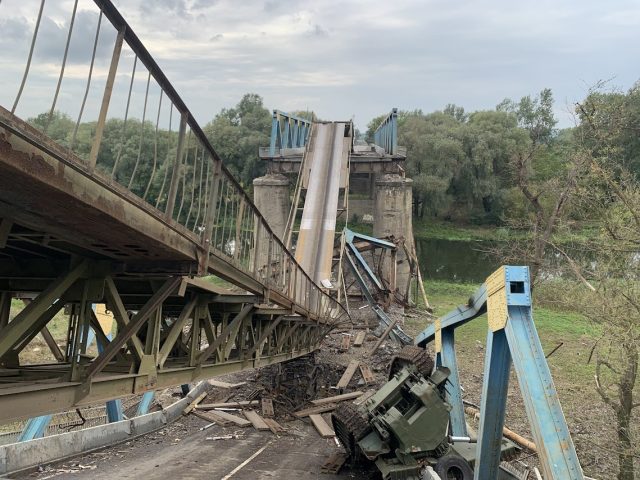
Everything is perceived in comparison
NZ: From the street, from below, it is absolutely impossible to imagine the amount of destruction that is visible from a drone. When you look from below, well, maybe you see the roof has tilted a little, and in reality there are actually 5 holes in the roof. That is, the number of hits is so great that it is absolutely difficult to estimate from below. It is very difficult to estimate the scale. It is even impossible to compare with Northern Saltivka district of Kharkiv.
IC: Everything is perceived in comparison.
NZ: Yes.
Publishing photos and videos immediately is dangerous.
IR: Will your drone videos be available in the near future or not?
NZ: It’s just dangerous to publish them now. We never release such information quickly. So, when the security structures decide to make this information public, we will gladly publish it. This was the case with the destruction of Northern Saltivka. Our drone was the first there and participated in the macro-documentation of the destruction since May 2022. But we began to very carefully publish photos only after the Security Service of Ukraine released the first video. It is fundamental security matter for us. We do not publish information that has not been published by the official bodies.
IC: It is clear that we do not know something. There are some moments before permission from the authorities will be given.
NZ: We do not ask for permission. Our cooperation with the authorities is based entirely on trust. We’re just taking our time. That’s all.
The problem can be as follows: for example, a drone can show where an electrical substation is being repaired. This is enough information for the enemy to target.
In Izyum, it can be seen that the occupier was fleeing.
NZ: In Izyum, it can be seen that the occupier was fleeing. Everything is abandoned there. They didn’t think about covering their tracks. They did not think to somehow hide their locations, etc. And it is very visible. Such information, the remains of something left occupiers, I think, should not be shown where it is.
IC: They cannot know what they left, because a subordinate told the commanders that the equipment was destroyed so that he would not be punished. And in fact, it already works for us.
NZ: Yes, definitely. They may say they set it on fire, when in fact it is perfectly usable.
IC: It’s one thing that we describe something in text mode, and it’s quite another thing when it’s on video.
NZ: I can provide an example from Kharkiv, from North Saltivka district, the videographer was filming with a 360-degree camera, and later when inspecting the photo on a big screen, he saw a bomb parachute hanging on the 6th floor of the building. And no one noticed this parachute before for months, it was only possible to see it on an enlarged photo. Our media are of very high quality nowadays, all videos are 4K, and photos up to 6K. We may not even understand ourselves what can be harmful. But the enemy can inspect these photos carefully, he has a lot of resources for this.
Photos and videos from Izyum will be available later
IC: However, when it will be possible to publish these things, do you plan in any media distribution?
NZ: Yes, definitely. We are currently preparing the expansion of our exhibition “Fracture. Kharkiv”. These will be several exhibits of “Fracture. Izyum”. Our exhibition is planned in London in December. And we have a desire to make life-size exhibits. Whether there will be prints on banner fabric like now, or whether there will be projections on the walls, we will see. It can be a destroyed two-story school in natural size.
IC: Really exiting! It would be cool to share it in the media, so there will be no tweets like Elon Musk’s.
NZ: Someday we will display our exhibition in the USA. If we are invited, we will go there. The exhibition was on display in Prague, Warsaw, in many locations in Ukraine, and it is planned to be in Porto. Should Musk invite us, then we will show it to Musk.
Crime documenters need help of professional psychiatrists
IC: You need to work with the media. In my opinion, there should be a state program of support for NGOs, because that would be more effective.
NZ: I agree. In fact, to do what we do, you need to have very good training plus very strong nerves. I saw how the journalists are emotionally devastated by what they see.
IC: I was afraid to ask about it.
NZ: We are getting psychiatric help. We have a volunteer counselor who is a registered advanced psychiatric nurse from Baltimore. We are also preparing special activities that can help us to reduce trauma.
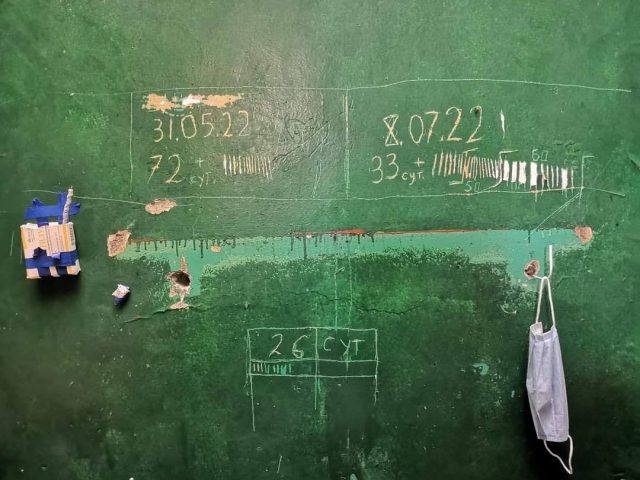
IC: Some sort of emotional relief.
NZ: Yes. It is absolutely necessary for everyone. In this work, there is no one who is not affected by what is happening.
IC: It’s good that you and your team understand this and use the help of psychologists. Alas, with the Soviet upbringing, it is still not convenient to ask for the help of psychologist…
NZ: No, we do have psychiatric care, not psychological care. I want to say that the most important thing here is to have a good psychiatrist. Our volunteer is on the other side of the planet. She is in the USA. I doubt I would find such help here in Kharkiv.
IK: I don’t know how about Kharkiv, but there are good crisis psychologists in Ukraine.
NZ: Once again: a psychiatrist and a psychologist are different. She works according to protocols that we do not have here. The protocols they use in the USA are for police officers, firefighters, that is, for people who work at disaster sites. These protocols are not widely available for us yet.
IC: Can you name her?
NZ: Yes. Her name is Sonia Kagna. She is originally from Kharkiv. She was a history teacher here. Then she moved to the USA and got a new profession there. (Read her memories of Kharkiv in English). She volunteered to help us. And we are very grateful to her.
The town lived in a different reality for five months.
NZ: What is important to understand about Izyum is that the city lived in a different reality for five months. They were completely cut off from information about Ukraine and from Ukraine.
People who managed to escape from the occupation told us, that they could get the Internet access briefly on the mountain top and they were hunted by the occupying forces trying to stop such attempts. Ukrainian radio could be heard only in a tiny part of the city. Majority had no access to radio or television. Instead, Russian newspapers were published. The occupiers broadcasted their own radio. And most people actually lived in a different reality.
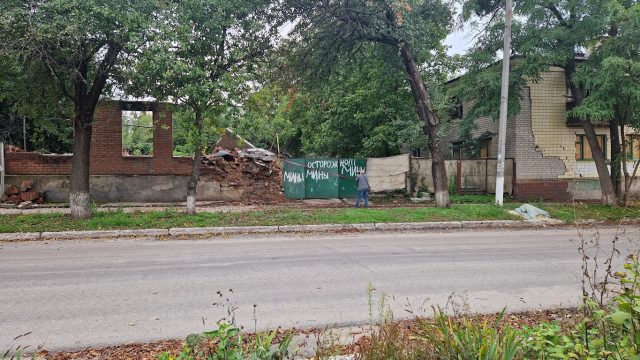
People believed that Russian Army was in Odessa or Kharkiv. One must understand that professionals should work with these people to get them out of such a traumatic state. Once the drone operator lost command of his drone and as a result found it and landed it on the central square of Izyum. People were resting there as it was a sunny day. And they were seriously frightened by the sight and the sound of a drone.
IC: Just from the sound a drone?
People are afraid
NZ: Yes. Demining is going on around there and something explodes, then people are frightened by every sound. The last time I saw something similar was in May at the metro station in Kharkiv. People, who lost their homes due to the shelling, lived there and they were afraid to go up from the subway. They were just afraid to go outside. The similar fear I saw in Izyum.
IC: And this is another problem. So many specialists are needed, and not only for Izyum.
NZ: Yes. And the longer the occupation, the more such specialists are needed. I want to tell you about a conversation.
A woman approached me and said:
— My windows are broken, what can be done about it?
— The prosecutors are here, approach them and declare the destruction.
— We were promised that someone will do something, but nothing happened…
I explained her the legal procedure. And she answered:
— I don’t trust anyone…
— If you don’t declare the damage, nothing will happen.
— But it will take long time.
— It will take a long time, but if you don’t apply, it will never happen.
And a she is not ready to listen and to do anything. And this conversation is typical near the damaged buildings.
IC: Thank you, Nataliya!
The authors of the photo are Nataliya Zubar, Jevhen Tytarenko, Juliia Gush, Kateryna Jashysh, Oleksii Svid, Petr Pojman
This project has been funded by Crown Agents International Development.




